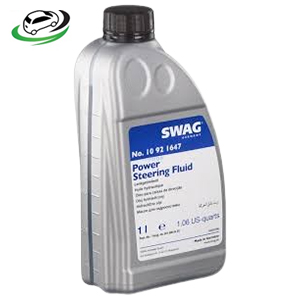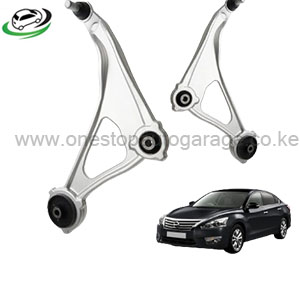-17%
FIND THE BEST PRICES NISSAN TEANA L33 FRONT Control Lower Arm set IN NAIROBI KENYA.
THE PRICES FOR NISSAN TEANA L33 FRONT SUSPENSION LOWER ARMS IS KSH 25000 per set IN NAIROBI KENYA.
Control arms are critical components in a vehicle’s suspension system, playing a crucial role in the overall performance, safety, and handling of the vehicle. These components, also known as A-arms or wishbones, connect the suspension to the frame and enable the controlled movement of the wheels. Understanding their functions and recognizing signs of wear is essential for maintaining a smooth and safe driving experience.
Functions of Control Arms:
1. Suspension Attachment:
Control arms serve as a crucial link between the suspension components and the vehicle’s frame. They act as a bridge, connecting the various elements of the suspension system, such as the shock absorber and coil spring, to the chassis. This attachment is vital for distributing forces and ensuring that the suspension system functions cohesively.
2. Wheel Movement:
One of the primary functions of control arms is to allow controlled movement of the wheels. As the vehicle encounters bumps, potholes, or uneven road surfaces, the control arms flex and pivot, enabling the wheels to move up and down independently. This capability contributes to a smoother ride by absorbing the impact of road irregularities and minimizing vibrations transmitted to the vehicle’s body.
3. Maintain Wheel Alignment:
Control arms play a pivotal role in maintaining proper wheel alignment. They are designed to position the wheels at precise angles relative to the vehicle’s frame. Proper alignment ensures optimal tire contact with the road, promoting even tire wear and enhancing vehicle stability. Misaligned wheels can lead to handling issues, reduced fuel efficiency, and uneven tire wear.
4. Dampen Shock and Vibration:
Control arms assist in dampening shocks and vibrations generated by road imperfections. Working in conjunction with other suspension components, such as shock absorbers, they help absorb and dissipate the energy produced when the wheels encounter bumps or obstacles. This contributes to a more comfortable and controlled driving experience.
Signs of Worn Out Control Arms:
1. Clunking or Knocking Noises:
Worn control arms often result in audible symptoms, such as clunking or knocking noises. These sounds may become pronounced when driving over bumps or rough terrain. The primary culprits are typically worn-out control arm bushings or ball joints. When these components deteriorate, they allow excessive play, leading to the characteristic noises.
2. Vibration in the Steering Wheel:
A noticeable vibration in the steering wheel can indicate issues with the control arms. Excessive wear on the bushings or ball joints can introduce play into the system, causing vibrations to be felt in the steering wheel. This symptom not only affects driving comfort but can also compromise the vehicle’s overall stability.
3. Uneven Tire Wear:
Worn control arms can disrupt proper wheel alignment, resulting in uneven tire wear. If you observe that the tread on your tires is wearing unevenly, with more wear on one side than the other, it may be a sign of control arm problems. Prompt attention to this issue is crucial to prevent further damage to the tires and ensure optimal performance.
4. Handling Issues:
As control arms deteriorate, they can significantly impact the vehicle’s handling. You may experience difficulty maintaining control during turns, reduced responsiveness in steering, or a general sense of instability. These handling issues can compromise the safety of the vehicle and necessitate a thorough inspection of the control arms.
5. Visible Damage or Rust:
Regular visual inspections of the control arms can reveal signs of wear. Look for visible damage, such as cracks, bends, or corrosion. Rust, in particular, can weaken the structural integrity of the control arms, making them more susceptible to failure. Any visible damage should be addressed promptly to prevent further deterioration.
6. Tire Alignment Issues:
If your vehicle tends to pull to one side, especially when driving straight, it may indicate control arm problems affecting wheel alignment. Misaligned wheels not only contribute to handling issues but can also lead to increased tire wear and reduced fuel efficiency. A proper wheel alignment is essential for the overall health of the vehicle’s suspension system.
7. Steering Wheel Play:
Excessive play in the steering wheel, where the wheel feels loose or unresponsive, can be a clear indication of control arm issues. Worn-out ball joints or bushings can introduce play into the steering system, compromising the vehicle’s steering precision and responsiveness.
8. Difficulty Steering:
Worn control arms can make steering more difficult, especially at higher speeds or when maneuvering. The increased resistance and lack of responsiveness can create a challenging driving experience, impacting both safety and comfort. If you notice increased effort required to steer the vehicle, it’s essential to have the control arms inspected promptly.
In conclusion, control arms are integral to the proper functioning of a vehicle’s suspension system. Recognizing the signs of worn-out control arms is crucial for addressing issues before they escalate, ensuring a safe and comfortable driving experience. Regular inspections, prompt maintenance, and timely replacement of worn components are essential practices for preserving the integrity of the suspension system and, by extension, the overall performance of the vehicle. If any of the aforementioned signs are observed, it is recommended to consult with a qualified mechanic to conduct a thorough inspection and address any issues promptly.



